Historic Nottingham - Part 6 - St. Mary The Virgin
w/e 15 July 2007
All this week's pictures were taken
with a Kodak DX6490
We take a pause in our walk through historic Nottingham
in this the sixth part of the series to see in a little more
detail of the Mother Church of the City dedicated to St. Mary
The Virgin. In 1797 a Samuel Booth married Sarah in this church
and it was their son William who went on to found the Salvation
Army.
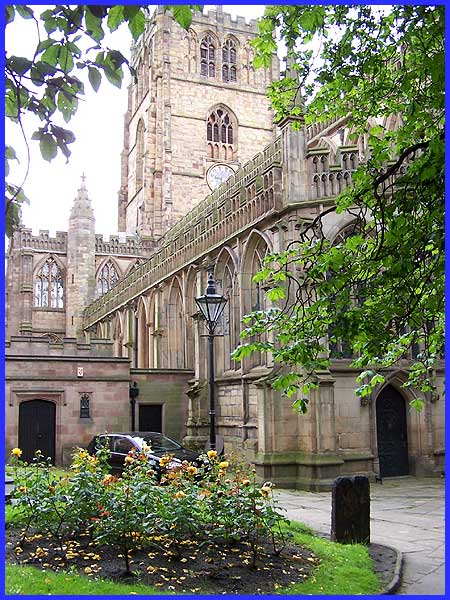
The nave of the present church was built over an earlier twelfth
century church that was demolished when the new building was
completed in 1474. Since then the church has undergone several
major restorations and in 1844 it only survived by a narrow margin
at a public meeting, a vote calling for its demolition and the
construction of a new church from scratch.
|
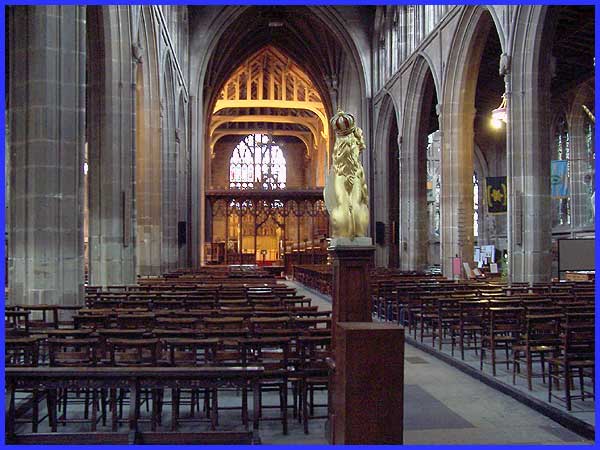
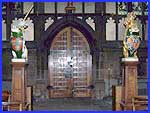 The
church did survive though and nineteenth century restorations
were carried out by a number of notable people including among
others, William Stretton, Sir Gilbert Scott, Bodley and Garner
and Temple Moore. The roof of the nave, restored by Scott, has
carved oak angels on the corbels. I had to look it up and if
you too didn't know, a "corbel" is a "bracket
projecting from the face of a wall used to support a cornice
or arch". At the western end of the nave the centre aisle
is flanked by a lion and a unicorn (right) that date from the
eighteenth century and bear the arms of the City and Queen Anne. The
church did survive though and nineteenth century restorations
were carried out by a number of notable people including among
others, William Stretton, Sir Gilbert Scott, Bodley and Garner
and Temple Moore. The roof of the nave, restored by Scott, has
carved oak angels on the corbels. I had to look it up and if
you too didn't know, a "corbel" is a "bracket
projecting from the face of a wall used to support a cornice
or arch". At the western end of the nave the centre aisle
is flanked by a lion and a unicorn (right) that date from the
eighteenth century and bear the arms of the City and Queen Anne.
|
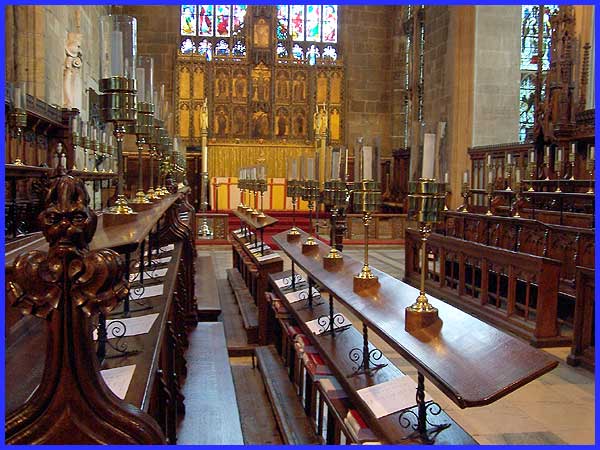
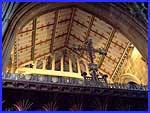 The
stalls and Bishop's Throne in the Choir are also by Sir Gilbert
Scott and date from 1871/72. The brass light fittings are of
much more recent origin having been donated by the Friends of
St. Mary's on Advent Sunday in 1996. The screen seen at a distance
in the previous picture of the nave and also partly in the small
image of the ceiling on the right is by Bodley and Garner dates
from 1885. An interesting aside is that when the original medieval
stalls were replaced, they were sold from a market stall to the
organist of Sneinton Church where they can still be seen to this
day. And you thought recycling was something new! The
stalls and Bishop's Throne in the Choir are also by Sir Gilbert
Scott and date from 1871/72. The brass light fittings are of
much more recent origin having been donated by the Friends of
St. Mary's on Advent Sunday in 1996. The screen seen at a distance
in the previous picture of the nave and also partly in the small
image of the ceiling on the right is by Bodley and Garner dates
from 1885. An interesting aside is that when the original medieval
stalls were replaced, they were sold from a market stall to the
organist of Sneinton Church where they can still be seen to this
day. And you thought recycling was something new!
|
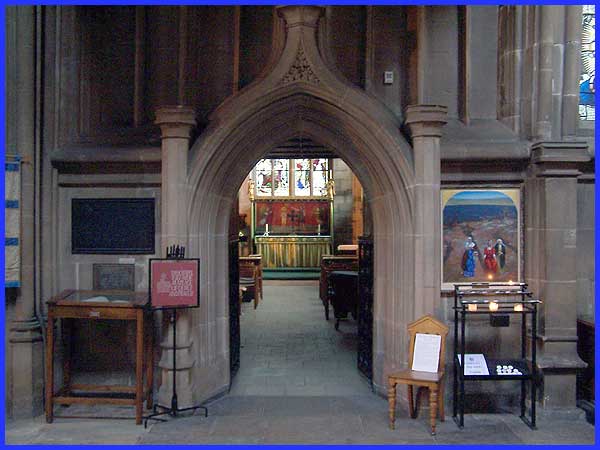
The Chapel of the Holy Spirit at the south east corner of the
church was built in 1913 but the side windows incorporate fragments
of medieval stained glass.
|
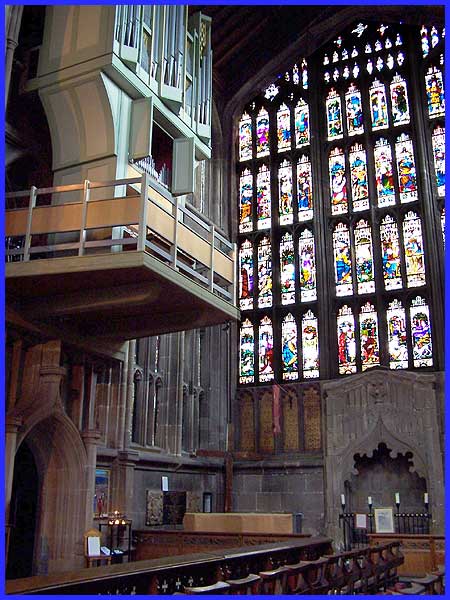
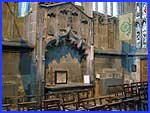 There
is also a large amount of stained glass in the South Transept.
The window originally had plain glass to allow the light to flow
in - a revolutionary idea at the time - but later generations
preferred, quoting from the church guide, "to worship in
an atmosphere of reverent gloom and filled the spaces with stained
glass." The tomb below is that of John Samon, Mayor of Nottingham
who died in 1416. This is balanced by a similar tomb in the North
Transept (left) for John de Tannersley another Mayor who died
in 1413. The picture above also shows the organ of 1973 by Marcussen
of Denmark above the door to the Chapel of the Holy Spirit. There
is also a large amount of stained glass in the South Transept.
The window originally had plain glass to allow the light to flow
in - a revolutionary idea at the time - but later generations
preferred, quoting from the church guide, "to worship in
an atmosphere of reverent gloom and filled the spaces with stained
glass." The tomb below is that of John Samon, Mayor of Nottingham
who died in 1416. This is balanced by a similar tomb in the North
Transept (left) for John de Tannersley another Mayor who died
in 1413. The picture above also shows the organ of 1973 by Marcussen
of Denmark above the door to the Chapel of the Holy Spirit.
|
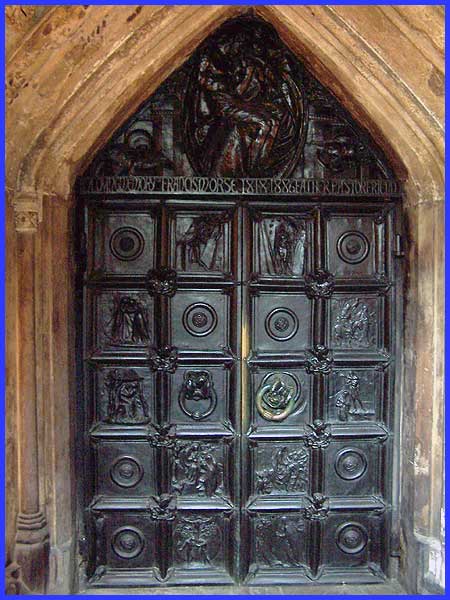
 We leave
the church by another door - that of the South Porch. The porch
is of early fifteenth century construction with a stone roof
and unusual pointed arch. The inner bronze doors of the porch
by Henry Wilson (1905) pictured above, depict scenes from the
life of Jesus Christ. We leave
the church by another door - that of the South Porch. The porch
is of early fifteenth century construction with a stone roof
and unusual pointed arch. The inner bronze doors of the porch
by Henry Wilson (1905) pictured above, depict scenes from the
life of Jesus Christ.
There are many more features in the church that I have not mentioned
or pictured here such as the fifteenth century font and the seventeenth
century Communion Table used during Puritan times but it is time
to move on and we will resume our walk leaving the churchyard
through the south west gate onto High Pavement where we will
continue in Part 7.
|

